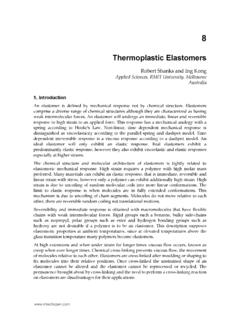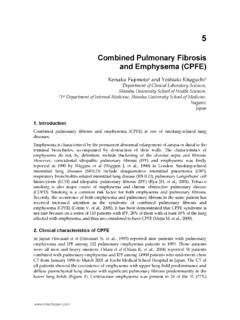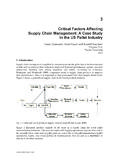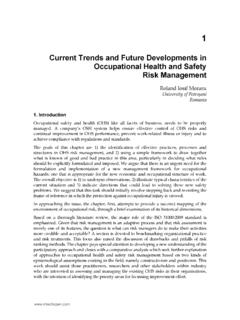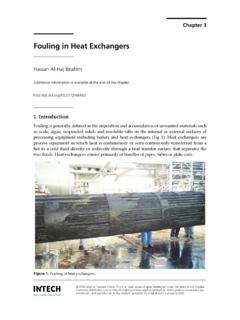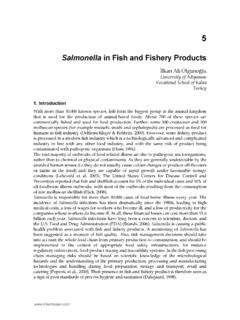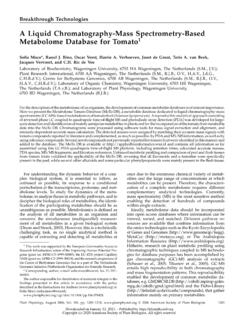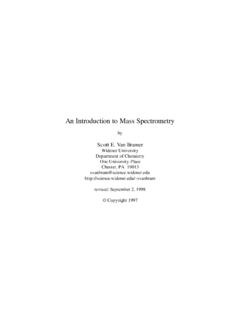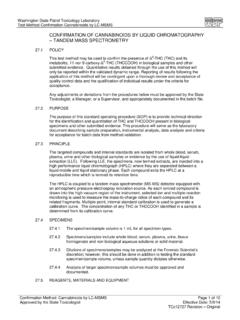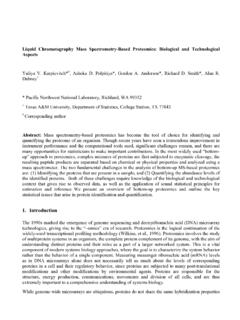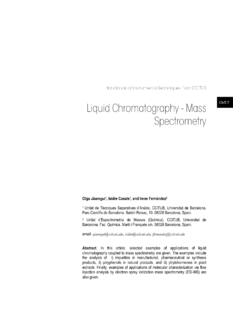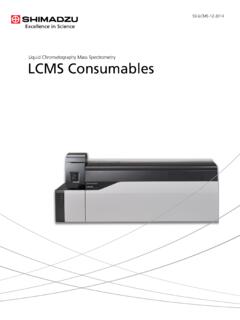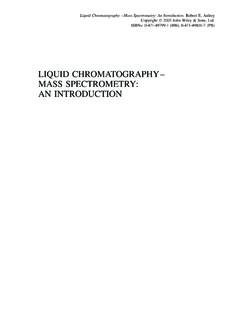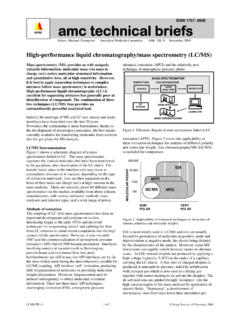Transcription of Gas Chromatography-Mass Spectrometry
1 Chapter 1 Gas Chromatography-Mass SpectrometryElena Stashenko and Jairo Ren Mart nezAdditional information is available at the end of the IntroductionGas chromatography (GC) is a widely applied technique in many branches of science andtechnology. For over half a century, GC has played a fundamental role in determining howmany components and in what proportion they exist in a mixture. However, the ability toestablish the nature and chemical structure of these separated and quantified compounds isambiguous and reduced, and requires a spectroscopic detection system. The most used, is themass spectrometric detector (MSD), which allows obtaining the "fingerprint" of the molecule, , its mass spectrum. mass spectra provide information on the molecular weight, elementalcomposition, if a high resolution mass spectrometer is used, functional groups present, and,in some cases, the geometry and spatial isomerism of the Gas chromatographyIn a gas chromatographic system, the sample to be analyzed may be a liquid solution or acollection of molecules adsorbed on a surface, , the solid-phase microextraction (SPME)system.
2 During the transfer into the GC, the sample is volatilized by rapid exposure to a zonekept at relatively high temperature (200-300 C) and mixed with a stream of carrier gas (Ar,He, N2, or H2). The resulting gaseous mixture enters the separation section, a chromatographiccolumn, which in its current version is a fused-silica tubular capillary coated internally witha thin polymer film. Upon their displacement through the column, analyte molecules arepartitioned between the gas carrier stream (mobile phase) and the polymer coating (stationaryphase), to an extent which depends mainly on their chemical structure. At the end of theseparation section, the molecules reach a detection system in which a specific physical property(thermal conductivity) or a physico-chemical process (ionization in a flame, electron capture)gives rise to an electric signal which is proportional to the amount of molecules of the same 2014 The Author(s). Licensee InTech.
3 This chapter is distributed under the terms of the Creative CommonsAttribution License ( ), which permits unrestricted use,distribution, and reproduction in any medium, provided the original work is properly A data system permits to process these data to produce a graph of the variation ofthis detector signal with time (chromatogram). Thus, four principal sections are distinguish able in the chromatograph: introduction (injector), separation (chromatographic column),detection, and data handling units. Each section has its own function and its responsibility forthe quality of the analysis and the results obtained. The injection system, for example, shouldideally transfer the sample to the column quantitatively, without discrimination on molecularweights or volatility, and without chemical alteration (decomposition or isomerization). It isa critical step, especially for quantitative analysis. For correct GC operation, among otherconditions, this gateway to the column should remain unpolluted, clean, inert, and main requirement for an analyte in GC is that it should be volatile enough to be presentin detectable amounts in the mobile phase.
4 Substances with low vapor pressure will not enterthe chromatographic column, will accumulate at the injection system, and may eventually clogits conduits. Very polar, thermolabile, ionic and high-molecular weight compounds are notcompatible with regular GC analysis. Depending on the molecular structure of the analyte andthe functional groups available, it is possible in some cases to obtain a chemical derivativewhich has a higher vapor pressure and is therefore more amenable to GC of the most important characteristics of the chromatographic column is its resolution, orthe ability to separate components with very similar distribution constants between the mobileand stationary phases (KD). Chromatographic resolution is a function of many operationalparameters. Among them, the nature of the stationary phase, mobile phase, temperature, thesize of the column, that is, its length (L), inner diameter (ID) and the thickness of the stationaryphase (df).
5 As the number of components in the mixture increases, and the structural similaritybetween its components grows (isomerism), longer columns are required for completecompound separation. Alternatively, for the same purpose, one can employ smaller internaldiameter columns. Obviously, increasing the length of the column markedly increases theanalysis time. So, as the analysis of polyaromatic hydrocarbons (PAHs) or controlled drugs isregularly accomplished using 30 m long columns, the separation of hydrocarbons in gasolinerequires longer, 100 m Sample preparation for GC analysisSample preparation for GC analysis involves techniques which preferentially isolate volatileand semi-volatile substances and prevent the presence of ionic or high molecular weightspecies in the mixture to be injected into the GC. These techniques can be divided roughly intothree major groups: Distillation, Extraction, and Headspace Methods. Additionally, there aresome sui generis methods which combine techniques from two different groups, for example,SDE, Simultaneous Distillation Solvent Extraction [1].
6 Distillation techniques exploitdifferences (must be large) in physicochemical properties (volatility or vapor pressure). Whenapplied to vegetal material or to other solid matrix which contains volatile compounds, thedistillation can be performed in different ways: (1) Steam distillation (SD), (2) hydrodistillation(HD), or (3) Water-Steam distillation. The resulting extracts or distillates are volatile mixturessuitable to GC or GC-MS analysis, which may only require a drying step (addition of sodiumsulfate) prior to injection into the chromatograph. Some distillation processes are designed toAdvances in Gas Chromatography2isolate particular substances or fractions at reduced pressure (vacuum) in special columns(molecular distillation) and many operate at industrial scale. However, in general, thesetechniques are not suitable for studying and isolating compounds at trace order to improve extraction efficiency and substantially reduce distillation times, micro wave radiation has been actively used in the past 30 years as heat source [2,3].
7 Microwave-assisted hydrodistillation (MWHD) is a common example of a lab-scale technique for essentialoil and other volatile mixture isolation which requires about of the time employed whenconventional heating is used in HD. Microwave-assisted extraction is used mostly for theextraction of solid samples (plant material, soil, tissue, etc.), with water or an organic solventas the extracting agent [4].The second family of techniques includes various methods of extraction where the analyteisolation is based on differences in their solubilities in solvent(s) or in the adsorption orabsorption on a material such as a microporous solid (activated carbon, silica gel, alumina,molecular sieves, etc.) or a porous polymer (PDMS, Tenax, Porapak, Chromosorb, syntheticresins, etc.). liquid - liquid extraction (LLE) in continuous or batch mode is the most used solubility-basedextraction method for liquid samples. Extraction selectivity is achieved by a proper choice ofsolvent (polarity, boiling point, dielectric constant, hydrogen bonding capacity, availability,accessibility, cost, etc.)
8 The extract obtained must often undergo clean-up and concentrationprocesses. However, LLE poses a number of technical problems, among others, emulsionformation, high cost, long extraction times, automation difficulties, toxic solvent disposal,possibility of cross contamination, etc. Despite these difficulties, the number of publishedworks that involve the use of LLE grew during the last decade [5]. Solid-phase extraction (SPE)has emerged during the last 4 decades as an alternative to LLE [6]. It substantially reduces theuse of solvents and combines extraction, clean-up and target analyte concentration into a singlestep. In addition, the method includes the possibility of automation. Another solubility-basedextraction technique employs a solvent at temperature and pressure above its critical fluid extraction (SFE) requires an initially high investment in equipment, but hasbeen used increasingly in areas in which traces of the extraction agent are not desired (naturalproducts, environmental, food, forensic, and in many industrial applications).
9 In this regard,carbon dioxide is the most common fluid employed because when the extract is returned tostandard temperature and pressure conditions, CO2 separates completely in a spontaneousmanner because it is a permanent gas under this conditions. SFE selectivity is achieved byvarying the operating conditions (temperature and pressure), which modify the supercriticalfluid density and in turn, the solubility of the analyte [7]. The use of co-solvents (ethanol,acetone) is another option, particularly, to enhance the extraction of polar substances. For GC-MS analysis, the SFE extract often requires additional cleaning steps to remove fats or pig ments, waxes or other high-molecular weight compounds (Figure 1).Soxhlet extraction is a solubility-based extraction method for solid samples. It s one of the mosttraditional extraction methods, used in the analysis of soil, polymers, natural products, etc., inareas such as biochemistry, agricultural sciences, biology, or environmental research.
10 Thisexhaustive extraction affords mixtures which require clean-up to remove heavy componentsGas Chromatography-Mass other interferences. Long experimental times and high solvent consumption in Soxhletextraction have led to its replacement in many applications by most efficient methods, such asAccelerated Solvent Extraction (ASE) [8]. In ASE, the use of higher temperature and pressurepermits to attain higher selectivity while significantly reducing the time and the amount ofsolvent required. Extraction, concentration and clean-up are performed in a single step, andthe equipment may be coupled in line with GC-MS. me- - >200000400000600000800000100000012000001 4000001600000180000020000002200000240000 026000002800000 AbundanceAPalmitic acidLinoleic acidLinolenic acidSt ear i c aci dNer olNer al8-HeptadeceneHexadecanalPal mi t ol ei c aci dC15C23C25C27C29200000400000600000800000 1000000120000014000001600000180000020000 002200000240000026000002800000 AbundanceTi me- - > benzoateTr i cosane, C23 Pent acosane, C25 Benzyl salicylate8- Hept adeceneCi nnamyl acet at eHept acosane, C27 Henei cosane, C21 Figure 1.


